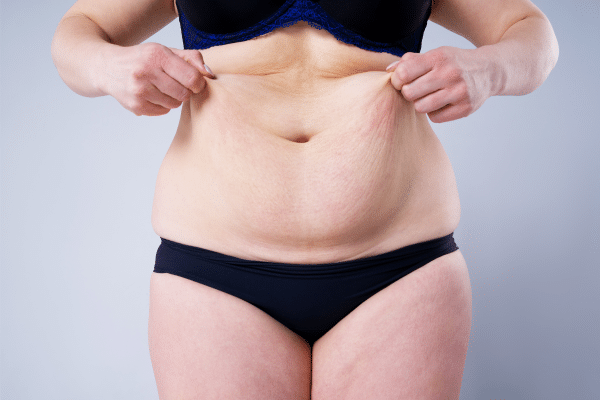Tummy tuck scar care starts with choosing the right plastic surgeon — a surgeon who is board certified like Dr. Schulman, has experience performing tummy tuck surgery in NYC, and is someone you are compatible with. Of course, you should look for other important qualities as well, but these are a good place to start.
Once you’ve got the right surgeon, it really comes down to you. It is your responsibility, during your tummy tuck recovery period, to follow your surgeon’s directions and care for your body as well as possible for optimal healing and scar formation.
Fortunately — despite the fact that we cannot perform a tummy tuck without at least one significant incision — your resulting scar (or scars) do not have to be highly noticeable! In this guide, we’ll outline everything you need to know about tummy tuck scars and how to properly care for them during your recovery.
Tummy Tuck Scars: An Overview
A standard tummy tuck requires at least one major incision to be made laterally on the lower abdomen (one is generally also made around the belly button, but it is easily concealed within the belly button). For many patients, this lower incision will leave a visible scar from hip bone to hip bone.
However, the good news is that this scar will be easily hidden beneath the bikini line. So, wearing even small bathing suit bottoms or most styles of underwear will cover it.
For other patients who require more extensive loose skin and excess fat removal, a vertical scar will also be created from an incision that needs to run from the lateral abdominal incision up to the navel.
Finally, certain patients may need the lower incision made in the pubic area to extend on either side around toward their back. This allows for more excess skin to be removed from the sides, flanks, and back area.
What Do Scars From a Tummy Tuck Look Like?
Visible scars after a tummy tuck are red or bright pink right after surgery. They will be held together with sutures and covered in surgical dressings. They will be swollen and tender as they heal and scar tissue is formed.
Once the incisions have healed together, incisions will still be pigmented and slightly raised at first. Over time and throughout the healing process, they will fade and flatten. Depending on your skin type, they may end up looking anywhere from pale pink or soft brown to white or cream-colored. Full tummy tuck results and advanced diminishment of scar appearance may not be completely achieved for six months up to one or more years.
How to Care for Tummy Tuck Scars

These individuals have usually lost a significant amount of weight or gone through one or more pregnancies, resulting in uncomfortable folds of excess skin around their midsections. Removal of this skin provides lasting benefits, including more comfort, improved ease of exercise, easier-to-fit-into clothing, and increased confidence. A scar that will ideally fade and become far less visible over time is typically a small price to pay.
Still, if you are going to have a tummy tuck, you do want those scars to fade as much as possible. And besides choosing the right plastic surgeon, you’re the one who can achieve this. Here are the steps to follow:
Undergo abdominoplasty at the right time.
Having had a tummy tuck surgery prior to a pregnancy should not put you or your baby at risk. However, one or multiple pregnancies after a tummy tuck may diminish your results.
Therefore, if you are considering children in the future, it’s best to wait until you’ve concluded your childbearing years before undergoing tummy tuck surgery. If you have questions about creating the optimal timeline, consult with your surgeon.
Follow your post-surgery recovery instructions.
A tummy tuck is a major procedure. For the first few months after surgery, you will need to take it easy. Do not expect to be back at work the next day or lifting your children or anything heavy for several weeks. Cardio and other forms of vigorous exercise are off the table for a while.
Instead, focus on caring for yourself and following your surgeon’s post-surgery treatment plan. Bruising, swelling and inflammation, pain and wound site irritation are all normal side effects.
Avoid putting stress or tension on your incisions, and follow wound care instructions to avoid infection. Once cleared, taking short walks can increase blood supply and circulation as you heal.
Avoid sun exposure.
Sunlight and UV rays can exacerbate the appearance of your scars, increasing skin redness and making scars more pigmented and noticeable overall. Therefore, avoid tanning and any type of UV exposure. If you can’t help it and your scars will be exposed to UV rays, plan to use sunscreen (as long as your incisions have fully healed).
Lead a healthy lifestyle.
Keeping yourself at a healthy stable weight and eating a balanced diet during your recovery period and afterward are key steps to achieving optimal results and maintaining them. This goes for the wound healing process, scar fading, and your overall abdominoplasty results.
Once you are cleared to exercise again, keep up a regular routine of light cardio and strength training. Staying in shape through diet and exercise will help maintain your results for as long as possible and provide a myriad of additional benefits.
Try surgeon-recommended topical treatments.
Topical products such as silicone scar sheets and gels can help to reduce the appearance of scars over time. It’s important to use these as directed and to start as soon as you are cleared to do so by your surgeon. Regular, consistent use of silicone has shown to reduce scar appearance significantly in studies.
Q&A: Tummy Tuck Scars and Recovery
What does a tummy tuck scar after 6 months look like?
After 6 months, a tummy tuck scar will be far less noticeable than the original wound site and scar. Ideally, it will appear as a thin, flat, light-colored line.
Is a mini tummy tuck scar smaller than a regular tummy tuck scar?
Yes, generally speaking, a mini tummy tuck scar is smaller than a full tummy tuck scar. It is usually positioned low on the abdomen and is designed for patients with less excess skin and fat to remove.
What is a tummy tuck scar tattoo?
A tummy tuck scar tattoo refers to the practice of getting a tattoo to cover or incorporate the tummy tuck scar, making it more aesthetically appealing or meaningful to the individual.
What are tummy tuck keloid scars?
Tummy tuck keloid scars are raised and thickened scars that can develop after surgery. They may extend beyond the original incision site. When keloid or hypertrophic scars occur, treatments such as tummy tuck scar revision or silicone sheeting may be considered to provide correction.
Set Up Your Consultation With Dr. Schulman Today

Contact our New York City office today to schedule a consultation appointment with board certified plastic surgeon Dr. Matthew Schulman. Renowned surgeon Dr. Schulman has extensive experience performing tummy tuck surgery for tummy tuck candidates from around the world. Call today to schedule your initial consultation, and start your journey toward the new you.
References
https://www.plasticsurgery.org/news/blog/what-kind-of-scar-can-you-expect-after-a-tummy-tuck




